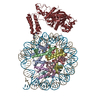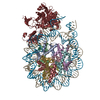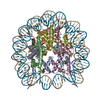[English] 日本語
 Yorodumi
Yorodumi- EMDB-34589: Cryo-EM structure of the p300 catalytic core bound to the H4K12ac... -
+ Open data
Open data
- Basic information
Basic information
| Entry |  | |||||||||
|---|---|---|---|---|---|---|---|---|---|---|
| Title | Cryo-EM structure of the p300 catalytic core bound to the H4K12acK16ac nucleosome, class 2 (3.9 angstrom resolution) | |||||||||
 Map data Map data | ||||||||||
 Sample Sample |
| |||||||||
 Keywords Keywords | Acetyl taransferase / Complex / Nucleosome / TRANSFERASE / TRANSFERASE-DNA complex | |||||||||
| Function / homology |  Function and homology information Function and homology informationbehavioral defense response / negative regulation of protein oligomerization / peptidyl-lysine propionylation / histone lactyltransferase (CoA-dependent) activity / peptidyl-lysine crotonylation / peptidyl-lysine butyrylation / histone butyryltransferase activity / swimming / peptide butyryltransferase activity / regulation of tubulin deacetylation ...behavioral defense response / negative regulation of protein oligomerization / peptidyl-lysine propionylation / histone lactyltransferase (CoA-dependent) activity / peptidyl-lysine crotonylation / peptidyl-lysine butyrylation / histone butyryltransferase activity / swimming / peptide butyryltransferase activity / regulation of tubulin deacetylation / histone H3K122 acetyltransferase activity / histone H2B acetyltransferase activity / internal protein amino acid acetylation / peptide 2-hydroxyisobutyryltransferase activity / histone crotonyltransferase activity / protein propionyltransferase activity / NOTCH2 intracellular domain regulates transcription / thigmotaxis / L-lysine N-acetyltransferase activity, acting on acetyl phosphate as donor / positive regulation of TORC2 signaling / internal peptidyl-lysine acetylation / histone H4 acetyltransferase activity / cellular response to L-leucine / histone H3 acetyltransferase activity / NFE2L2 regulating ER-stress associated genes / acetylation-dependent protein binding / Activation of the TFAP2 (AP-2) family of transcription factors / NFE2L2 regulating inflammation associated genes / NGF-stimulated transcription / N-terminal peptidyl-lysine acetylation / histone H3K18 acetyltransferase activity / LRR FLII-interacting protein 1 (LRRFIP1) activates type I IFN production / NFE2L2 regulates pentose phosphate pathway genes / histone H3K27 acetyltransferase activity / STAT3 nuclear events downstream of ALK signaling / Polo-like kinase mediated events / NFE2L2 regulating MDR associated enzymes / host-mediated activation of viral transcription / TGFBR3 expression / regulation of androgen receptor signaling pathway / regulation of mitochondrion organization / Regulation of gene expression in late stage (branching morphogenesis) pancreatic bud precursor cells / Regulation of FOXO transcriptional activity by acetylation / RUNX3 regulates NOTCH signaling / NOTCH4 Intracellular Domain Regulates Transcription / Nuclear events mediated by NFE2L2 / Regulation of NFE2L2 gene expression / Regulation of gene expression by Hypoxia-inducible Factor / face morphogenesis / platelet formation / NOTCH3 Intracellular Domain Regulates Transcription / regulation of glycolytic process / TRAF6 mediated IRF7 activation / NFE2L2 regulating tumorigenic genes / NFE2L2 regulating anti-oxidant/detoxification enzymes / megakaryocyte development / protein-lysine-acetyltransferase activity / nuclear androgen receptor binding / acyltransferase activity / STAT family protein binding / protein acetylation / Formation of paraxial mesoderm / positive regulation of transforming growth factor beta receptor signaling pathway / acetyltransferase activity / FOXO-mediated transcription of cell death genes / PI5P Regulates TP53 Acetylation / stimulatory C-type lectin receptor signaling pathway / fat cell differentiation / RUNX1 interacts with co-factors whose precise effect on RUNX1 targets is not known / Zygotic genome activation (ZGA) / histone acetyltransferase complex / RUNX3 regulates p14-ARF / negative regulation of tumor necrosis factor-mediated signaling pathway / intrinsic apoptotic signaling pathway in response to DNA damage by p53 class mediator / canonical NF-kappaB signal transduction / NF-kappaB binding / negative regulation of gluconeogenesis / pre-mRNA intronic binding / Attenuation phase / somitogenesis / negative regulation of protein-containing complex assembly / positive regulation of DNA-binding transcription factor activity / positive regulation of T-helper 17 cell lineage commitment / cellular response to nutrient levels / histone acetyltransferase activity / protein localization to CENP-A containing chromatin / Chromatin modifying enzymes / skeletal muscle tissue development / histone acetyltransferase / regulation of cellular response to heat / Replacement of protamines by nucleosomes in the male pronucleus / CENP-A containing nucleosome / NR1H3 & NR1H2 regulate gene expression linked to cholesterol transport and efflux / SARS-CoV-1 targets host intracellular signalling and regulatory pathways / Packaging Of Telomere Ends / Regulation of TP53 Activity through Acetylation / Recognition and association of DNA glycosylase with site containing an affected purine / Cleavage of the damaged purine / : / Transferases; Acyltransferases; Transferring groups other than aminoacyl groups Similarity search - Function | |||||||||
| Biological species |  Homo sapiens (human) Homo sapiens (human) | |||||||||
| Method | single particle reconstruction / cryo EM / Resolution: 3.9 Å | |||||||||
 Authors Authors | Kikuchi M / Morita S / Wakamori M / Shin S / Uchikubo-Kamo T / Shirouzu M / Umehara T | |||||||||
| Funding support |  Japan, 1 items Japan, 1 items
| |||||||||
 Citation Citation |  Journal: Nat Commun / Year: 2023 Journal: Nat Commun / Year: 2023Title: Epigenetic mechanisms to propagate histone acetylation by p300/CBP. Authors: Masaki Kikuchi / Satoshi Morita / Masatoshi Wakamori / Shin Sato / Tomomi Uchikubo-Kamo / Takehiro Suzuki / Naoshi Dohmae / Mikako Shirouzu / Takashi Umehara /  Abstract: Histone acetylation is important for the activation of gene transcription but little is known about its direct read/write mechanisms. Here, we report cryogenic electron microscopy structures in which ...Histone acetylation is important for the activation of gene transcription but little is known about its direct read/write mechanisms. Here, we report cryogenic electron microscopy structures in which a p300/CREB-binding protein (CBP) multidomain monomer recognizes histone H4 N-terminal tail (NT) acetylation (ac) in a nucleosome and acetylates non-H4 histone NTs within the same nucleosome. p300/CBP not only recognized H4NTac via the bromodomain pocket responsible for reading, but also interacted with the DNA minor grooves via the outside of that pocket. This directed the catalytic center of p300/CBP to one of the non-H4 histone NTs. The primary target that p300 writes by reading H4NTac was H2BNT, and H2BNTac promoted H2A-H2B dissociation from the nucleosome. We propose a model in which p300/CBP replicates histone N-terminal tail acetylation within the H3-H4 tetramer to inherit epigenetic storage, and transcribes it from the H3-H4 tetramer to the H2B-H2A dimers to activate context-dependent gene transcription through local nucleosome destabilization. | |||||||||
| History |
|
- Structure visualization
Structure visualization
| Supplemental images |
|---|
- Downloads & links
Downloads & links
-EMDB archive
| Map data |  emd_34589.map.gz emd_34589.map.gz | 138.8 MB |  EMDB map data format EMDB map data format | |
|---|---|---|---|---|
| Header (meta data) |  emd-34589-v30.xml emd-34589-v30.xml emd-34589.xml emd-34589.xml | 20.3 KB 20.3 KB | Display Display |  EMDB header EMDB header |
| FSC (resolution estimation) |  emd_34589_fsc.xml emd_34589_fsc.xml | 12 KB | Display |  FSC data file FSC data file |
| Images |  emd_34589.png emd_34589.png | 72.7 KB | ||
| Masks |  emd_34589_msk_1.map emd_34589_msk_1.map | 149.9 MB |  Mask map Mask map | |
| Filedesc metadata |  emd-34589.cif.gz emd-34589.cif.gz | 6.8 KB | ||
| Others |  emd_34589_half_map_1.map.gz emd_34589_half_map_1.map.gz emd_34589_half_map_2.map.gz emd_34589_half_map_2.map.gz | 118.3 MB 118.1 MB | ||
| Archive directory |  http://ftp.pdbj.org/pub/emdb/structures/EMD-34589 http://ftp.pdbj.org/pub/emdb/structures/EMD-34589 ftp://ftp.pdbj.org/pub/emdb/structures/EMD-34589 ftp://ftp.pdbj.org/pub/emdb/structures/EMD-34589 | HTTPS FTP |
-Validation report
| Summary document |  emd_34589_validation.pdf.gz emd_34589_validation.pdf.gz | 883.1 KB | Display |  EMDB validaton report EMDB validaton report |
|---|---|---|---|---|
| Full document |  emd_34589_full_validation.pdf.gz emd_34589_full_validation.pdf.gz | 882.7 KB | Display | |
| Data in XML |  emd_34589_validation.xml.gz emd_34589_validation.xml.gz | 19.3 KB | Display | |
| Data in CIF |  emd_34589_validation.cif.gz emd_34589_validation.cif.gz | 25.6 KB | Display | |
| Arichive directory |  https://ftp.pdbj.org/pub/emdb/validation_reports/EMD-34589 https://ftp.pdbj.org/pub/emdb/validation_reports/EMD-34589 ftp://ftp.pdbj.org/pub/emdb/validation_reports/EMD-34589 ftp://ftp.pdbj.org/pub/emdb/validation_reports/EMD-34589 | HTTPS FTP |
-Related structure data
| Related structure data |  8hahMC  8hagC  8haiC  8hajC  8hakC  8halC  8hamC  8hanC M: atomic model generated by this map C: citing same article ( |
|---|---|
| Similar structure data | Similarity search - Function & homology  F&H Search F&H Search |
- Links
Links
| EMDB pages |  EMDB (EBI/PDBe) / EMDB (EBI/PDBe) /  EMDataResource EMDataResource |
|---|---|
| Related items in Molecule of the Month |
- Map
Map
| File |  Download / File: emd_34589.map.gz / Format: CCP4 / Size: 149.9 MB / Type: IMAGE STORED AS FLOATING POINT NUMBER (4 BYTES) Download / File: emd_34589.map.gz / Format: CCP4 / Size: 149.9 MB / Type: IMAGE STORED AS FLOATING POINT NUMBER (4 BYTES) | ||||||||||||||||||||||||||||||||||||
|---|---|---|---|---|---|---|---|---|---|---|---|---|---|---|---|---|---|---|---|---|---|---|---|---|---|---|---|---|---|---|---|---|---|---|---|---|---|
| Projections & slices | Image control
Images are generated by Spider. | ||||||||||||||||||||||||||||||||||||
| Voxel size | X=Y=Z: 0.829 Å | ||||||||||||||||||||||||||||||||||||
| Density |
| ||||||||||||||||||||||||||||||||||||
| Symmetry | Space group: 1 | ||||||||||||||||||||||||||||||||||||
| Details | EMDB XML:
|
-Supplemental data
-Mask #1
| File |  emd_34589_msk_1.map emd_34589_msk_1.map | ||||||||||||
|---|---|---|---|---|---|---|---|---|---|---|---|---|---|
| Projections & Slices |
| ||||||||||||
| Density Histograms |
-Half map: #2
| File | emd_34589_half_map_1.map | ||||||||||||
|---|---|---|---|---|---|---|---|---|---|---|---|---|---|
| Projections & Slices |
| ||||||||||||
| Density Histograms |
-Half map: #1
| File | emd_34589_half_map_2.map | ||||||||||||
|---|---|---|---|---|---|---|---|---|---|---|---|---|---|
| Projections & Slices |
| ||||||||||||
| Density Histograms |
- Sample components
Sample components
-Entire : the p300 catalytic core bound to the H4K12acK16ac nucleosome
| Entire | Name: the p300 catalytic core bound to the H4K12acK16ac nucleosome |
|---|---|
| Components |
|
-Supramolecule #1: the p300 catalytic core bound to the H4K12acK16ac nucleosome
| Supramolecule | Name: the p300 catalytic core bound to the H4K12acK16ac nucleosome type: complex / ID: 1 / Parent: 0 / Macromolecule list: #1-#6 / Details: p300 was expressed in insect cells. |
|---|---|
| Source (natural) | Organism:  Homo sapiens (human) Homo sapiens (human) |
-Macromolecule #1: Histone H3.1
| Macromolecule | Name: Histone H3.1 / type: protein_or_peptide / ID: 1 / Number of copies: 2 / Enantiomer: LEVO |
|---|---|
| Source (natural) | Organism:  Homo sapiens (human) Homo sapiens (human) |
| Molecular weight | Theoretical: 15.305969 KDa |
| Recombinant expression | Organism:  |
| Sequence | String: ARTKQTARKS TGGKAPRKQL ATKAARKSAP ATGGVKKPHR YRPGTVALRE IRRYQKSTEL LIRKLPFQRL VREIAQDFKT DLRFQSSAV MALQEACEAY LVGLFEDTNL CAIHAKRVTI MPKDIQLARR IRGERA UniProtKB: Histone H3.1 |
-Macromolecule #2: Histone H4
| Macromolecule | Name: Histone H4 / type: protein_or_peptide / ID: 2 / Number of copies: 2 / Enantiomer: LEVO |
|---|---|
| Source (natural) | Organism:  Homo sapiens (human) Homo sapiens (human) |
| Molecular weight | Theoretical: 11.345289 KDa |
| Recombinant expression | Organism:  |
| Sequence | String: SGRGKGGKGL G(ALY)GGA(ALY)RHRK VLRDNIQGIT KPAIRRLARR GGVKRISGLI YEETRGVLKV FLENVIRDAV TY TEHAKRK TVTAMDVVYA LKRQGRTLYG FGG |
-Macromolecule #3: Histone H2A type 1-B/E
| Macromolecule | Name: Histone H2A type 1-B/E / type: protein_or_peptide / ID: 3 / Number of copies: 2 / Enantiomer: LEVO |
|---|---|
| Source (natural) | Organism:  Homo sapiens (human) Homo sapiens (human) |
| Molecular weight | Theoretical: 14.034355 KDa |
| Recombinant expression | Organism:  |
| Sequence | String: SGRGKQGGKA RAKAKTRSSR AGLQFPVGRV HRLLRKGNYS ERVGAGAPVY LAAVLEYLTA EILELAGNAA RDNKKTRIIP RHLQLAIRN DEELNKLLGR VTIAQGGVLP NIQAVLLPKK TESHHKAKGK UniProtKB: Histone H2A type 1-B/E |
-Macromolecule #4: Histone H2B type 1-J
| Macromolecule | Name: Histone H2B type 1-J / type: protein_or_peptide / ID: 4 / Number of copies: 2 / Enantiomer: LEVO |
|---|---|
| Source (natural) | Organism:  Homo sapiens (human) Homo sapiens (human) |
| Molecular weight | Theoretical: 13.804045 KDa |
| Recombinant expression | Organism:  |
| Sequence | String: PEPAKSAPAP KKGSKKAVTK AQKKDGKKRK RSRKESYSIY VYKVLKQVHP DTGISSKAMG IMNSFVNDIF ERIAGEASRL AHYNKRSTI TSREIQTAVR LLLPGELAKH AVSEGTKAVT KYTSAK UniProtKB: Histone H2B type 1-J |
-Macromolecule #6: Histone acetyltransferase p300
| Macromolecule | Name: Histone acetyltransferase p300 / type: protein_or_peptide / ID: 6 / Number of copies: 1 / Enantiomer: LEVO / EC number: histone acetyltransferase |
|---|---|
| Source (natural) | Organism:  Homo sapiens (human) Homo sapiens (human) |
| Molecular weight | Theoretical: 92.314391 KDa |
| Recombinant expression | Organism:  Trichoplusia ni (cabbage looper) Trichoplusia ni (cabbage looper) |
| Sequence | String: GSSGSSGIFK PEELRQALMP TLEALYRQDP ESLPFRQPVD PQLLGIPDYF DIVKSPMDLS TIKRKLDTGQ YQEPWQYVDD IWLMFNNAW LYNRKTSRVY KYCSKLSEVF EQEIDPVMQS LGYCCGRKLE FSPQTLCCYG KQLCTIPRDA TYYSYQNRYH F CEKCFNEI ...String: GSSGSSGIFK PEELRQALMP TLEALYRQDP ESLPFRQPVD PQLLGIPDYF DIVKSPMDLS TIKRKLDTGQ YQEPWQYVDD IWLMFNNAW LYNRKTSRVY KYCSKLSEVF EQEIDPVMQS LGYCCGRKLE FSPQTLCCYG KQLCTIPRDA TYYSYQNRYH F CEKCFNEI QGESVSLGDD PSQPQTTINK EQFSKRKNDT LDPELFVECT ECGRKMHQIC VLHHEIIWPA GFVCDGCLKK SA RTRKENK FSAKRLPSTR LGTFLENRVN DFLRRQNHPE SGEVTVRVVH ASDKTVEVKP GMKARFVDSG EMAESFPYRT KAL FAFEEI DGVDLCFFGM HVQEYGSDCP PPNQRRVYIS YLDSVHFFRP KCLRTAVYHE ILIGYLEYVK KLGYTTGHIW ACPP SEGDD YIFHCHPPDQ KIPKPKRLQE WYKKMLDKAV SERIVHDYKD IFKQATEDRL TSAKELPYFE GDFWPNVLEE SIKEL EQEE EERKREENTS NESTDVTKGD SKNAKKKNNK KTSKNKSSLS RGNKKKPGMP NVSNDLSQKL YATMEKHKEV FFVIRL IAG PAANSLPPIV DPDPLIPCDL MDGRDAFLTL ARDKHLEFSS LRRAQWSTMC MLVELHTQSQ DRFVYTCNEC KHHVETR WH CTVCEDYDLC ITCYNTKNHD HKMEKLGLGL DDESNNQQAA ATQSPGDSRR LSIQRCIQSL VHACQCRNAN CSLPSCQK M KRVVQHTKGC KRKTNGGCPI CKQLIALCCY HAKHCQENKC PVPFCLNIKQ KLRQQQLQHR LQQAQMLRRR MASMQ UniProtKB: Histone acetyltransferase p300 |
-Macromolecule #5: DNA (180-mer)
| Macromolecule | Name: DNA (180-mer) / type: dna / ID: 5 / Number of copies: 2 / Classification: DNA |
|---|---|
| Source (natural) | Organism:  Homo sapiens (human) Homo sapiens (human) |
| Molecular weight | Theoretical: 55.560527 KDa |
| Sequence | String: (DA)(DT)(DC)(DC)(DG)(DT)(DC)(DC)(DG)(DT) (DT)(DA)(DC)(DC)(DG)(DC)(DC)(DA)(DT)(DC) (DA)(DA)(DT)(DA)(DT)(DC)(DC)(DA)(DC) (DC)(DT)(DG)(DC)(DA)(DG)(DA)(DT)(DT)(DC) (DT) (DA)(DC)(DC)(DA)(DA)(DA) ...String: (DA)(DT)(DC)(DC)(DG)(DT)(DC)(DC)(DG)(DT) (DT)(DA)(DC)(DC)(DG)(DC)(DC)(DA)(DT)(DC) (DA)(DA)(DT)(DA)(DT)(DC)(DC)(DA)(DC) (DC)(DT)(DG)(DC)(DA)(DG)(DA)(DT)(DT)(DC) (DT) (DA)(DC)(DC)(DA)(DA)(DA)(DA)(DG) (DT)(DG)(DT)(DA)(DT)(DT)(DT)(DG)(DG)(DA) (DA)(DA) (DC)(DT)(DG)(DC)(DT)(DC)(DC) (DA)(DT)(DC)(DA)(DA)(DA)(DA)(DG)(DG)(DC) (DA)(DT)(DG) (DT)(DT)(DC)(DA)(DG)(DC) (DT)(DG)(DA)(DA)(DT)(DT)(DC)(DA)(DG)(DC) (DT)(DG)(DA)(DA) (DC)(DA)(DT)(DG)(DC) (DC)(DT)(DT)(DT)(DT)(DG)(DA)(DT)(DG)(DG) (DA)(DG)(DC)(DA)(DG) (DT)(DT)(DT)(DC) (DC)(DA)(DA)(DA)(DT)(DA)(DC)(DA)(DC)(DT) (DT)(DT)(DT)(DG)(DG)(DT) (DA)(DG)(DA) (DA)(DT)(DC)(DT)(DG)(DC)(DA)(DG)(DG)(DT) (DG)(DG)(DA)(DT)(DA)(DT)(DT) (DG)(DA) (DT)(DG)(DG)(DC)(DG)(DG)(DT)(DA)(DA)(DC) (DG)(DG)(DA)(DC)(DG)(DG)(DA)(DT) |
-Experimental details
-Structure determination
| Method | cryo EM |
|---|---|
 Processing Processing | single particle reconstruction |
| Aggregation state | particle |
- Sample preparation
Sample preparation
| Buffer | pH: 7.2 |
|---|---|
| Vitrification | Cryogen name: ETHANE |
- Electron microscopy
Electron microscopy
| Microscope | TFS KRIOS |
|---|---|
| Image recording | Film or detector model: GATAN K3 BIOQUANTUM (6k x 4k) / Average electron dose: 50.0 e/Å2 |
| Electron beam | Acceleration voltage: 300 kV / Electron source:  FIELD EMISSION GUN FIELD EMISSION GUN |
| Electron optics | Illumination mode: FLOOD BEAM / Imaging mode: BRIGHT FIELD / Nominal defocus max: 2.0 µm / Nominal defocus min: 0.8 µm |
| Experimental equipment |  Model: Titan Krios / Image courtesy: FEI Company |
 Movie
Movie Controller
Controller








































 Z (Sec.)
Z (Sec.) Y (Row.)
Y (Row.) X (Col.)
X (Col.)














































